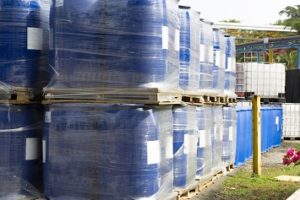Yesterday we looked at three scenarios concerning the Department of Transportation’s (DOT) materials of trade (MOT) exception to the hazardous materials transportation regulations. Today we will review the quantity and packaging requirements you must meet in order to take advantage of this popular exception.
Note: The MOT exception allows the use of some containers that do not meet United Nations specifications, and it waives requirements for formal training, emergency response information, shipping papers, and placarding. However, the exception’s requirements include strict quantity limits and hazard communication on the packaging. Also, the MOT exception does not apply to all hazardous materials classes and divisions, and it applies only to private motor carriers.
However, you may transport MOT with other hazardous materials without losing your eligibility for the MOT exception.
Quantity Limits
The quantity limit is based on the class or division of hazardous materials being transported.
Except for a diluted mixture of a Class 9 material, the aggregate gross weight of all MOT on a motor vehicle may not exceed 440 pounds (lb) (200 kilograms (kg)).
For Class 3, 8, 9, Division 4.1, 5.1, 5.2, 6.1, or ORM-D materials, the gross mass or capacity of the packaging is limited to:
- Up to 1 lb (0.5 kg) or 1 pint (pt) (0.5 liter (l)) for a Packing Group I material;
- Up to 66 lb (30 kg) or 8 gallons (gal) (30 l) for a Packing Group II, Packing Group III, or ORM-D material; or
- Up to 400 gal (1,500 l) for a diluted mixture, not to exceed 2 percent concentration, of a Class 9 material.
For Division 2.1 or 2.2 material:
- In a cylinder with a gross weight up to 220 lb (100 kg);
- In a Dewar flask meeting the requirements of 49 CFR 173.320 (i.e., exceptions for cryogenic liquids); or
- A permanently mounted tank manufactured to the ASME Code of not more than 70 gal water capacity for a nonliquefied Division 2.2 material with no subsidiary hazard.
For Division 4.3 material in Packing Group II or III, the gross capacity of the packaging may not exceed 1 ounce (30 milliliters (ml)).
For Division 6.2 material (not applicable to Category A substances), other than a regulated medical waste, the quantity limits are:
- For one or more inner packagings, each inner packaging may contain up to 1.1 lb (0.5 kg) or 17 ounces (0.5 l); and
- An outer packaging may contain up to 8.8 lb (4 kg) or 1 gal (4 l); or
- A single inner packaging may contain up 35.2 lb (16 kg) or 4.2 gal (16 l) in a single outer packaging.
For a regulated medical waste, a combination packaging is required and quantity limits are:
- For one or more inner packagings, each packaging may contain up to 8.8 lb (4 kg) or 1 gal (4 l); and
- An outer packaging may contain up to 35.2 lb (16 kg) or 4.2 gal (16 l).
Packaging
There are general packaging requirements and/or exceptions for all classes and divisions for which the MOT exception is applicable. In addition, there are specific packaging requirements and/or exceptions for Division 6.2 materials, gasoline, and pressure vessels containing Division 2.1 and 2.2 material.
General requirements:
- Packaging must be leak tight for liquids and gases, siftproof for solids, and be securely closed, secured against shifting, and protected against damage.
- Each material must be packaged in the manufacturer’s original packaging or a packaging of equal or greater strength and integrity.
Outer packagings are not required for:
- Receptacles (e.g., cans and bottles) that are secured against shifting, and
- Cylinders and other pressure vessels that contain Division 2.1 or 2.2 materials. Manifolding of cylinders is allowed as long as all valves are tightly closed.
For gasoline, a packaging must be made of metal or plastic and conform to MOT requirements or to the requirements for flammable liquids under the Occupational Safety and Health Administration (OSHA) general industry or construction standard for flammable liquids (29 CFR 1910.106(d)(2) and 1926.152(a)(1), respectively).
For Division 6.2 material (not applicable to Category A infectious substances) the material must be contained in a combination packaging.
For liquids:
- Inner packaging must be leakproof, and
- Outer packaging must contain sufficient absorbent material to absorb the entire contents of the inner packaging.
For sharps:
- Inner packaging (i.e., the sharps container) must be constructed of a rigid material resistant to punctures and securely closed to prevent leaks or punctures; and
- Outer packaging must be securely closed to prevent leaks or punctures.
For solids, liquids, and sharps, the outer packaging must be a strong, tight packaging securely closed and secured against shifting.
Hazard Communication
MOT hazard communication requirements include:
- A nonbulk packaging other than a cylinder must be marked with a common name or proper shipping name. It must include the letters “RQ” if it contains a reportable quantity of a hazardous substance.
- A bulk packaging containing a diluted mixture of a Class 9 material must be marked on two opposing sides with the 4-digit identification number of the material.
- A DOT specification cylinder (except DOT specification 39) must be marked and labeled as prescribed in this subchapter. DOT-39 (nonrefillable) cylinders must display the markings specified in 49 CFR 178.65(i).
- The driver of a motor vehicle that contains an MOT must be informed of the presence of the hazardous material (including whether the package contains a reportable quantity) and must be informed of the MOT requirements.

